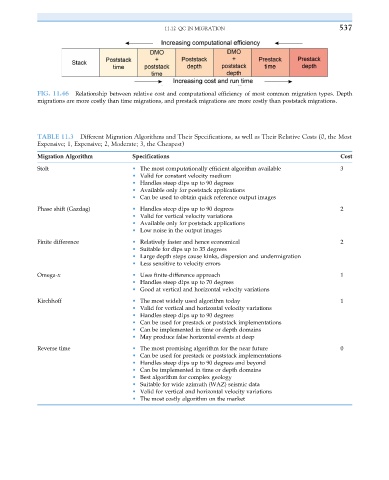Page 546 - Acquisition and Processing of Marine Seismic Data
P. 546
11.12 QC IN MIGRATION 537
FIG. 11.46 Relationship between relative cost and computational efficiency of most common migration types. Depth
migrations are more costly than time migrations, and prestack migrations are more costly than poststack migrations.
TABLE 11.3 Different Migration Algorithms and Their Specifications, as well as Their Relative Costs (0, the Most
Expensive; 1, Expensive; 2, Moderate; 3, the Cheapest)
Migration Algorithm Specifications Cost
Stolt • The most computationally efficient algorithm available 3
• Valid for constant velocity medium
• Handles steep dips up to 90 degrees
• Available only for poststack applications
• Can be used to obtain quick reference output images
Phase shift (Gazdag) • Handles steep dips up to 90 degrees 2
• Valid for vertical velocity variations
• Available only for poststack applications
• Low noise in the output images
Finite difference • Relatively faster and hence economical 2
• Suitable for dips up to 35 degrees
• Large depth steps cause kinks, dispersion and undermigration
• Less sensitive to velocity errors
Omega-x • Uses finite-difference approach 1
• Handles steep dips up to 70 degrees
• Good at vertical and horizontal velocity variations
Kirchhoff • The most widely used algorithm today 1
• Valid for vertical and horizontal velocity variations
• Handles steep dips up to 90 degrees
• Can be used for prestack or poststack implementations
• Can be implemented in time or depth domains
• May produce false horizontal events at deep
Reverse time • The most promising algorithm for the near future 0
• Can be used for prestack or poststack implementations
• Handles steep dips up to 90 degrees and beyond
• Can be implemented in time or depth domains
• Best algorithm for complex geology
• Suitable for wide azimuth (WAZ) seismic data
• Valid for vertical and horizontal velocity variations
• The most costly algorithm on the market

